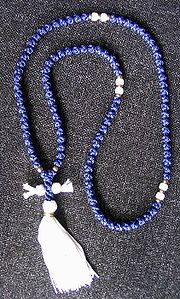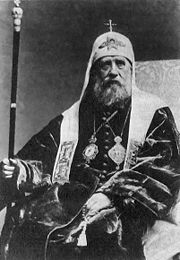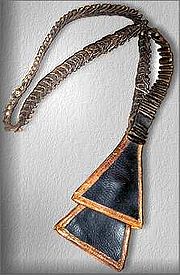
Prayer rope
Encyclopedia


Greek language
Greek is an independent branch of the Indo-European family of languages. Native to the southern Balkans, it has the longest documented history of any Indo-European language, spanning 34 centuries of written records. Its writing system has been the Greek alphabet for the majority of its history;...
: κομποσκοίνι, Russian
Russian language
Russian is a Slavic language used primarily in Russia, Belarus, Uzbekistan, Kazakhstan, Tajikistan and Kyrgyzstan. It is an unofficial but widely spoken language in Ukraine, Moldova, Latvia, Turkmenistan and Estonia and, to a lesser extent, the other countries that were once constituent republics...
: чётки, Romanian
Romanian language
Romanian Romanian Romanian (or Daco-Romanian; obsolete spellings Rumanian, Roumanian; self-designation: română, limba română ("the Romanian language") or românește (lit. "in Romanian") is a Romance language spoken by around 24 to 28 million people, primarily in Romania and Moldova...
: mătănii, Macedonian
Macedonian language
Macedonian is a South Slavic language spoken as a first language by approximately 2–3 million people principally in the region of Macedonia but also in the Macedonian diaspora...
and Serbian
Serbian language
Serbian is a form of Serbo-Croatian, a South Slavic language, spoken by Serbs in Serbia, Bosnia and Herzegovina, Montenegro, Croatia and neighbouring countries....
: бројаница / brojanica, Bulgarian
Bulgarian language
Bulgarian is an Indo-European language, a member of the Slavic linguistic group.Bulgarian, along with the closely related Macedonian language, demonstrates several linguistic characteristics that set it apart from all other Slavic languages such as the elimination of case declension, the...
: броеница) is a loop
Loop (knot)
In reference to knots, loop may refer to:* One of the fundamental structures used to tie knots. Specifically, it is a full circle formed by passing the working end over itself.* A type of knot used to create a closed circle in a line....
made up of complex knot
Knot
A knot is a method of fastening or securing linear material such as rope by tying or interweaving. It may consist of a length of one or several segments of rope, string, webbing, twine, strap, or even chain interwoven such that the line can bind to itself or to some other object—the "load"...
s, usually out of wool
Wool
Wool is the textile fiber obtained from sheep and certain other animals, including cashmere from goats, mohair from goats, qiviut from muskoxen, vicuña, alpaca, camel from animals in the camel family, and angora from rabbits....
or silk
Silk
Silk is a natural protein fiber, some forms of which can be woven into textiles. The best-known type of silk is obtained from the cocoons of the larvae of the mulberry silkworm Bombyx mori reared in captivity...
.
The prayer rope is part of the habit
Religious habit
A religious habit is a distinctive set of garments worn by members of a religious order. Traditionally some plain garb recognisable as a religious habit has also been worn by those leading the religious eremitic and anachoritic life, although in their case without conformity to a particular uniform...
of Eastern Orthodox monks and nuns and is employed by monastics (and sometimes by others) to count the number of times one has prayed
Prayer
Prayer is a form of religious practice that seeks to activate a volitional rapport to a deity through deliberate practice. Prayer may be either individual or communal and take place in public or in private. It may involve the use of words or song. When language is used, prayer may take the form of...
the Jesus Prayer
Jesus Prayer
The Jesus Prayer or "The Prayer" is a short, formulaic prayer esteemed and advocated within the Eastern Orthodox church:The prayer has been widely taught and discussed throughout the history of the Eastern Churches. It is often repeated continually as a part of personal ascetic practice, its use...
or, occasionally, other prayers.
Description

There is typically a knotted cross
Christian cross
The Christian cross, seen as a representation of the instrument of the crucifixion of Jesus Christ, is the best-known religious symbol of Christianity...
where the prayer rope is joined together to form a loop, and a few bead
Bead
A bead is a small, decorative object that is usually pierced for threading or stringing. Beads range in size from under to over in diameter. A pair of beads made from Nassarius sea snail shells, approximately 100,000 years old, are thought to be the earliest known examples of jewellery. Beadwork...
s at certain intervals between the knots (usually every 10 or 25 knots) for ease in counting. Longer prayer ropes frequently have a tassel at the end of the cross; its purpose is to dry the tears shed due to heartfelt compunction
Repentance
Repentance is a change of thought to correct a wrong and gain forgiveness from a person who is wronged. In religious contexts it usually refers to confession to God, ceasing sin against God, and resolving to live according to religious law...
for one's sins. The tassel can also be said to represent the glory of the Heavenly Kingdom
Kingdom of God
The Kingdom of God or Kingdom of Heaven is a foundational concept in the Abrahamic religions: Judaism, Christianity and Islam.The term "Kingdom of God" is found in all four canonical gospels and in the Pauline epistles...
, which one can only enter through the Cross.
The prayer rope is commonly made out of wool, symbolizing the flock of Christ; though in modern times other materials are used also. The traditional color of the rope is black (symbolizing mourning for one's sins), with either black or colored beads. The beads (if they are colored) and at least a portion of the tassel are traditionally red, symbolizing the blood of Christ and the blood of the martyrs. In recent times, however, prayer ropes have been made in a wide variety of colors.
Though prayer ropes are often tied by monastics, lay persons are permitted to tie them also. In proper practice, the person tying a prayer rope should be of true faith and pious life and should be praying the Jesus Prayer the whole time.
According to Orthodox Serbs, the 33 knotted prayer rope should be worn on the left hand, and when praying, held with the thumb and forefinger of the right hand. The 33 knots symbolize the age of Jesus Christ when he died.
Use


Sign of the cross
The Sign of the Cross , or crossing oneself, is a ritual hand motion made by members of many branches of Christianity, often accompanied by spoken or mental recitation of a trinitarian formula....
. When not in use, the prayer rope is traditionally wrapped around the left wrist so that it continues to remind one to pray without ceasing. If this is impractical, it may be placed in the (left) pocket, but should not be hung around the neck or suspended from the belt. The reason for this is humility: one should not be ostentatious or conspicuous in displaying the prayer rope for others to see.
During their Tonsure (religious profession), Eastern Orthodox Monks and Nuns are given a prayer rope, with the words:
Accept, O brother (sister) (name), the sword of the Spirit which is the word of God (Ephesians 6:17) in the everlasting Jesus prayer by which you should have the name of the Lord in your soul, your thoughts, and your heart, saying always: "Lord Jesus Christ, Son of God, have mercy on me a sinner."The prayer rope is considered to be the sword of the Spirit, because prayer which is heartfelt and inspired by the grace of the Holy Spirit
Holy Spirit
Holy Spirit is a term introduced in English translations of the Hebrew Bible, but understood differently in the main Abrahamic religions.While the general concept of a "Spirit" that permeates the cosmos has been used in various religions Holy Spirit is a term introduced in English translations of...
is a weapon that defeats the Devil
Devil in Christianity
In mainstream Christianity, the Devil is named Satan, and sometimes Lucifer. He is a fallen angel who rebelled against God. He is often identified as the serpent in the Garden of Eden, whose persuasions led to original sin and the need for Jesus Christ's redemption...
.
Among some Orthodox
Orthodox
Orthodox may refer to:In music:* Orthodox , album by the Czech death metal band KrabathorIn science:* File manager#Orthodox file managers in computing* Orthodox seed, seed which may be preserved via drying or freezing...
monastics (and occasionally other faithful), the canonical hours and preparation for Holy Communion may be replaced by praying the Jesus Prayer a specified number of times dependent on the service being replaced. In this way prayers can still be said even if the service books are for some reason unavailable or the person is not literate or otherwise unable to recite the service; the use of a prayer rope is a very practical tool
Tool
A tool is a device that can be used to produce an item or achieve a task, but that is not consumed in the process. Informally the word is also used to describe a procedure or process with a specific purpose. Tools that are used in particular fields or activities may have different designations such...
in such cases, simply for keeping count of the prayers said. However, among some monastics, e.g., hesychasts
Hesychasm
Hesychasm is an eremitic tradition of prayer in the Eastern Orthodox Church, and some of the Eastern Catholic Churches, such as the Byzantine Rite, practised by the Hesychast Hesychasm is an eremitic tradition of prayer in the Eastern Orthodox Church, and some of the Eastern Catholic Churches,...
s, this replacement is the norm.
One scheme for replacing the Divine Services with the Jesus Prayer is as follows:
- Instead of the entire Psalter: 6000 Jesus Prayers
- One kathismaKathismaA Kathisma , literally, "seat", is a division of the Psalter, used by Eastern Orthodox Christians and Eastern Catholics who follow the Byzantine Rite...
of the Psalter: 300 prayers (100 for each stasis)
- One kathisma
- Midnight OfficeMidnight OfficeThe Midnight Office is one of the Canonical Hours that compose the cycle of daily worship in the Eastern Orthodox Church. The office originated as a purely monastic devotion inspired by Psalm 118:62, At midnight I arose to give thanks unto Thee for the judgments of Thy righteousness , and also by...
: 600 - Matins: 1500
- The HoursLittle HoursThe Little Hours are the fixed daytime hours of prayer in the Divine Office of Christians, in both Western Christianity and the Eastern Orthodox Church. These Hours are called 'little' due to their shorter and simpler structure compared to the Night Hours...
without the Inter-Hours: 1000;- The Hours with the Inter-HoursInter-HoursThe Inter-Hours are brief services in the Daily Office of the Eastern Orthodox and Greek Catholic Churches. The Inter-Hours are called for during the Lenten seasons of the Church year...
: 1500
- The Hours with the Inter-Hours
- VespersVespersVespers is the evening prayer service in the Western Catholic, Eastern Catholic, and Eastern Orthodox, Anglican, and Lutheran liturgies of the canonical hours...
: 600 - Great ComplineComplineCompline is the final church service of the day in the Christian tradition of canonical hours. The English word Compline is derived from the Latin completorium, as Compline is the completion of the working day. The word was first used in this sense about the beginning of the 6th century by St...
: 700 - Small Compline: 400
- A CanonCanon (hymnography)A canon is a structured hymn used in a number of Eastern Orthodox services. It consists of nine odes, sometimes called canticles or songs depending on the translation, based on the Biblical canticles. Most of these are found in the Old Testament, but the final ode is taken from the Magnificat and...
or AkathistAkathistThe Akathist Hymn is a hymn of Eastern Orthodox and Eastern Catholic tradition dedicated to a saint, holy event, or one of the persons of the Holy Trinity...
to the Most Holy TheotokosTheotokosTheotokos is the Greek title of Mary, the mother of Jesus used especially in the Eastern Orthodox, Oriental Orthodox, and Eastern Catholic Churches. Its literal English translations include God-bearer and the one who gives birth to God. Less literal translations include Mother of God...
(Mother of God): 500
Over the centuries, various cell rules have developed to help the individual in the daily use of the prayer rope. However, there is no single, standardized method that is used universally throughout the Church. There may be prostrations
Zemnoy poklon
Poyasny and zemnoy poklon are different kinds of bows used in an Eastern Orthodox worship service....
after each prayer or after a certain number of prayers, depending upon the particular rule being followed.
Not only is the Jesus Prayer used, but Eastern Christians also have many "Breath Prayers". Contrary to thought, they are not to be said using spiritual breathing as that can only be determined by a spiritual father. Some breath prayers that are continuously repeated on the Prayer Rope are: Lord Have Mercy, Come Lord Jesus, Lord I Believe...Help My Unbelief, Lord Save Me, etc.
History

Psalms
The Book of Psalms , commonly referred to simply as Psalms, is a book of the Hebrew Bible and the Christian Bible...
every day. However, because some of the monks were unable to read, they would either have to memorize the psalms or perform other prayers and prostrations in their stead. Thus the tradition of saying 150 (or more) Jesus Prayers every day began.
The western Rosary
Rosary
The rosary or "garland of roses" is a traditional Catholic devotion. The term denotes the prayer beads used to count the series of prayers that make up the rosary...
is sometimes said to have the same initial origin.
The invention of the prayer rope is attributed to Saint Pachomius in the fourth century as an aid for illiterate monks
Monasticism
Monasticism is a religious way of life characterized by the practice of renouncing worldly pursuits to fully devote one's self to spiritual work...
to accomplish a consistent number of prayers and prostration
Prostration
Prostration is the placement of the body in a reverentially or submissively prone position. Major world religions employ prostration either as a means of embodying reverence for a noble person, persons or doctrine, or as an act of submissiveness to a supreme being or beings...
s in their cells. Previously, monks would count their prayers by casting pebbles into a bowl, but this was cumbersome, and could not be easily carried about when outside the cell. The use of the rope made it possible to pray the Jesus Prayer unceasingly, whether inside the cell or out, in accordance with Saint Paul
Paul of Tarsus
Paul the Apostle , also known as Saul of Tarsus, is described in the Christian New Testament as one of the most influential early Christian missionaries, with the writings ascribed to him by the church forming a considerable portion of the New Testament...
's injunction to "Pray without ceasing" (I Thessalonians 5:17).
It is said that the method of tying the prayer rope had its origins from the Father of Orthodox Monasticism, Saint Anthony the Great
Anthony the Great
Anthony the Great or Antony the Great , , also known as Saint Anthony, Anthony the Abbot, Anthony of Egypt, Anthony of the Desert, Anthony the Anchorite, Abba Antonius , and Father of All Monks, was a Christian saint from Egypt, a prominent leader among the Desert Fathers...
. He started by tying a leather rope with a simple knot for every time he prayed Kyrie Eleison
Kyrie
Kyrie, a transliteration of Greek κύριε , vocative case of κύριος , meaning "Lord", is the common name of an important prayer of Christian liturgy, which is also called the Kýrie, eléison ....
("Lord have Mercy"), but the Devil
Devil
The Devil is believed in many religions and cultures to be a powerful, supernatural entity that is the personification of evil and the enemy of God and humankind. The nature of the role varies greatly...
would come and untie the knots to throw off his count. He then devised a way--inspired by a vision he had of the Theotokos--of tying the knots so that the knots themselves would constantly make the sign of the cross. This is why prayer ropes today are still tied using knots that each contain seven little crosses being tied over and over. The Devil could not untie it because the Devil is vanquished by the Sign of the Cross.
See also
- HesychasmHesychasmHesychasm is an eremitic tradition of prayer in the Eastern Orthodox Church, and some of the Eastern Catholic Churches, such as the Byzantine Rite, practised by the Hesychast Hesychasm is an eremitic tradition of prayer in the Eastern Orthodox Church, and some of the Eastern Catholic Churches,...
- Jesus PrayerJesus PrayerThe Jesus Prayer or "The Prayer" is a short, formulaic prayer esteemed and advocated within the Eastern Orthodox church:The prayer has been widely taught and discussed throughout the history of the Eastern Churches. It is often repeated continually as a part of personal ascetic practice, its use...
- LestovkaLestovkaLestovka or vervitsa is a special type of prayer rope made of leather, once in general use in old Russia, and is still used by Russian Old Believers today, such as the Russian Orthodox Oldritualist Church.-Form and symbolism:...
- Prayer beadsPrayer beadsPrayer beads are used by members of various religious traditions such as Roman Catholicism, Orthodox Christianity, Anglicanism, Islam, Hinduism, Buddhism, Sikhism and Bahá'í Faith to count the repetitions of prayers, chants or devotions, such as the rosary of Virgin Mary in Christianity and dhikr ...
- RosaryRosaryThe rosary or "garland of roses" is a traditional Catholic devotion. The term denotes the prayer beads used to count the series of prayers that make up the rosary...
- TasbihTasbihA misbaha , subha , Tasbih , or tespih is a string of prayer beads which is traditionally used by Muslims to keep track of counting in tasbih....

